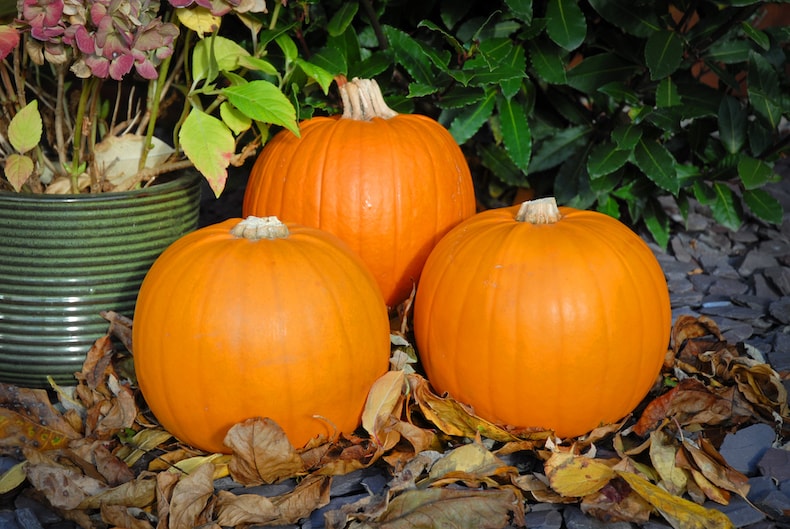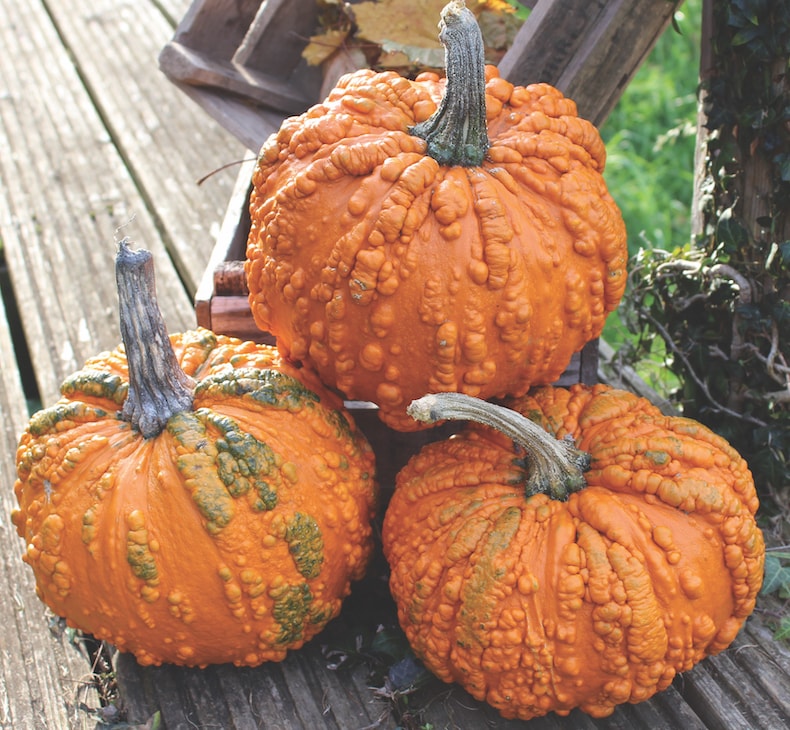How to grow pumpkins

Pumpkins are easy to grow from seed in your garden or allotment
Image: Pumpkin 'Jack of All Trades' from Thompson & Morgan/©Branded Garden Products
Pumpkins are magnificent autumn vegetables that are fun to grow and delicious to eat. All you need is a packet of pumpkin seeds, a sunny position and lots of water. Children love growing their own Halloween decorations and the flesh is delicious roasted, mashed or used as part of a warm winter soup. An excellent source of vitamins A and C, the seeds can be eaten as a healthy snack too!
Which pumpkin variety is best?

This heritage variety is said to have inspired the coach in the Cinderella fairytale
Image: Pumpkin Rouge Vif D'Etamps from Thompson & Morgan
Pumpkins come in all sizes and shapes, from tiny fruits to the enormous Pumpkin ‘Big Max’ that grows to a prize-winning 45kg! But before you begin growing giant pumpkins it’s wise to think about how much space you have to spare.
If you prefer traditional sized vegetables then ‘Jack Of All Trades’ is the perfect choice. With sweet orange flesh it’s ideal for carving and making sweet dishes like pies and cakes. And for something slightly different, why not try the small, attractive fruits of Pumpkin ‘Gold Speck'. Simply cut off the top, scoop out the seeds, season with salt and pepper and replace the top before cooking in the microwave until soft. Delicious!
When to sow pumpkins

Ideal for Halloween, these warty pumpkins make an excellent display
Image: Pumpkin 'Zombie' F1 Hybrid from Thompson & Morgan
Pumpkins require warm daytime temperatures of between 18 - 30C (68F) and prefer a minimum night temperature of 16C (61F), at least until they’re planted out. In cooler areas pumpkins can be sown indoors from April to mid May for transplanting outside later, when temperatures have risen.
However if you’re short of indoor space, you may prefer to wait until the soil has warmed up in late May or early June and sow your seeds directly outdoors. Wherever you choose to start them, it's best to sow two seeds per hole and thin the weakest plant out later on. And if you choose to direct sow outdoors, start your pumpkins off under cloches to give them the best start.
How to sow pumpkin seeds
Watch our short video above to see how resident horticulturist, Sue Sanderson, sows her ‘Jack of all Trades’ pumpkin seeds. Here’s a quick recap:
- You can wait until the soil has warmed up in late May, early June, and then direct sow your pumpkins outdoors. However I prefer to start mine indoors from mid-April, and then plant them out later on.
- Fill a small 7.5cm diameter pot with a good quality potting compost. Make sure you press the compost down gently to fill in any air gaps. It’s a good idea to use potting compost for pumpkins rather than seed sowing compost because it gives the plants more nutrients from the very start. Because pumpkin seeds are quite large, they won’t mind the coarser texture.
- Make a planting hole to a depth of about 2.5cm. Sow your pumpkin seeds on their sides to reduce the risk of rotting. And it’s a good idea to sow two seeds per hole in case one doesn’t germinate. If both come up you can just pinch one out, or transplant it into a separate pot.
- Water the compost well and then put your pots in a propagator, or seal them inside a plastic bag, at a temperature of about 20 degrees celsius until germination.
- Pumpkins are really vigorous growers and will literally burst from the soil within five to seven days. Once germinated they can be removed from the plastic bag or propagator, and grown on in cooler conditions until they’re ready to be planted outdoors.
- Make sure they receive plenty of light. The secret to success with pumpkins is to keep them well watered and nice and warm - between 18 and 25 degrees celsius - at least until you plant them outdoors.
How to plant out your pumpkins
To see how to plant out your pumpkins, watch the short video above. Here’s a quick recap:
- Gradually acclimatise your pumpkins to outdoor conditions over 7-10 days before transplanting them out into warm, well drained, humus rich soil. They prefer a position in full sun that’s sheltered from the wind. Choose a spot that receives at least 6 hours of direct sun per day and prepare the soil in advance, adding plenty of well rotted manure or compost.
- Planting distances can range from 90cm apart to 3m apart depending on the variety, so you’ll need to check the seed packet. At each planting station, pile the soil into mounds about 15cm (6") high. Plant each pumpkin plant on top of a mound to ensure good drainage and keep them well watered until they’re established.
- Pumpkins enjoy plenty of nitrogen so they appreciate a feed of general fertiliser a few weeks after planting. They will begin to produce long stems which can be trained in a circle around the plant to prevent them spreading too far. They have deep roots and are normally quite capable of finding their own water within the soil, but in very dry periods some supplementary watering may be required.
How feed and pollinate pumpkins
Pumpkins are very vigorous growers, so they need a lot of fertiliser throughout the season to keep them healthy. The video above shares lots of top tips to help with feeding and pollinating. Here’s a quick recap:
- Use a high nitrogen feed every week until the flowers start to appear, then switch to a high phosphorous feed. When the fruits begin to develop, switch back to a high potassium feed again. Pumpkins are thirsty plants too, and regular watering is essential if you want to produce a decent crop.
- Pumpkins are normally insect pollinated, but if the fruits aren’t setting then you may need to hand pollinate them. Female pumpkin flowers can be identified by a swollen bump at the base of the bloom, which the male flowers don't have. Don't be alarmed if the first few flowers are all male. This is normal, and you’ll start to find female flowers developing soon after.
- As the flowers develop, pick a single male flower and remove its petals. Press it against the centre of each female flower. If you prefer, you can tickle the centre of each flower with a small paintbrush to transfer the pollen from the male flower.
- If you’re growing pumpkins for Halloween then you’ll be hoping for the largest fruits possible. Select just two or three pumpkins per plant and remove all the others to focus the plant’s energy on your chosen fruit.
How and when to harvest pumpkins
Leave your pumpkins on the plant for as long as possible until the skin has hardened and the fruits start to crack near to the stem. But be sure to harvest them before the first frost. Cut each fruit from the stem, leaving several inches of the stem attached. Watch the video above for more harvesting advice.
Pumpkin growing tips

These flavoursome miniature pumpkins are perfect for carving and cooking
Image: Thompson & Morgan
- Pumpkins can be prone to rot if left to sit on wet ground so it’s a good idea to raise the fruits off the damp floor using a wooden board or a large upturned seed tray.
- They need lots of sun to ripen, so remove any foliage that’s casting shade.
- If you need your pumpkins for Halloween, you may need to harvest them a few weeks before and bring them into a warm room to help them ripen in time.
How to use pumpkins

Delicious to eat, pumpkins have plenty of decorative uses too
Image: Thompson & Morgan
- Table decorations - Use small pumpkins as table decorations along with a display of colourful autumn leaves. Or, if you're really creative, make individual place settings for your dinner party guests!
- Halloween carvings - Small pumpkins can look very effective and are easier for young children to handle. There are lots of free templates online that you can download to really impress your neighbours.
- Soup bowls - Pumpkin soup is delicious and looks really effective presented in hollowed-out pumpkins. Simply scoop out the flesh, making sure that the 'bowl' is sturdy enough to hold the soup. Take a look at our home-grown recipes page, where you'll find some great ideas for spicy pumpkin and butternut squash soups.
- Pumpkin seeds - Don't throw away your scooped out pumpkin innards! Simply wash and dry the seeds, sprinkle them with oil and a little salt and pepper before roasting in the oven. Use them as a garnish on soups and salads or enjoy as a tasty snack.
We hope this has answered all your pumpkin questions. Now all you need to do is decide which new variety of pumpkin seeds to try! Post your images on social and remember to tag us in using #YourTMGarden. Find more pumpkin advice and plenty about sowing and growing squashes too at our hub page.
Sign Up For Exclusive Special Offers




© 2025 Thompson & Morgan. All rights reserved. A division of Branded Garden Products Limited.
Sign up for exclusive offers!



